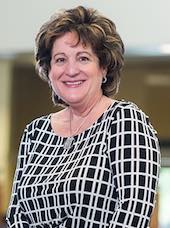8 minutes
Industry leaders share advice on surmounting obstacles that arise after breaking through the glass ceiling.
It has been suggested that women who break through the glass ceiling often find themselves on a “glass cliff.” In fact, there’s data to suggest that struggling companies tend to promote or recruit more female CEOs than male. Why?
Anna Beninger, senior director of research and corporate engagement partner at Catalyst, a nonprofit focused on promoting women in business, says this in an article from Vox: “When an organization is in crisis, women are often seen as being able to come in and take care of a problem.” They are, she suggests, “effectively handed the mess to clean up.”
Sometimes that works out for the organization—and the woman in the lead role—but often it doesn’t.
Female CEOs on the Chopping Block
The Vox article also points to a 2013 PricewaterhouseCoopers report that found “over a 10-year period, more women leaders were forced out of office than men—38 percent of women CEOs versus 27 percent of men CEOs.”
Lynn Heckler, CIE, EVP/chief talent officer with CUESolutions provider PSCU, St. Petersburg, Florida, says that the glass cliff phenomenon could apply in any industry, including credit unions. Perhaps there may be “some positive psychology behind hiring a female executive to ‘right the ship,’” but she suggests there may be something else at play. “A candidate from a typical executive demographic profile may not be willing to accept a very risky role, as they have many more options available, leaving the riskier roles open for female leaders.”
Jill Nowacki, CEO of CUES Supplier member Humanidei + O'Rourke, Ontario, California, agrees. Nowacki has been working in the industry since 2001, taking on leadership roles with credit unions and state and national trade associations.

“It is a reality that a company facing challenges might struggle to find a proven leader who wants to take over the top role,” she says. “In those circumstances, high-potential, first-time leaders may be an organization’s best bet for moving forward.” This can be a great opportunity for women, as well as for people of color and other young leaders. “This combination of an organization and an individual willing to take a chance on one another can lead to great outcomes,” she adds.
But what can female senior leaders—and those hoping to rise up the ranks—do to boost the odds that they will be able to lead their organizations successfully through troubled times?
Don’t Be Afraid to Make the Leap
First, suggests Heckler, don’t be hesitant to consider taking on a high-risk role. “My perspective is that willingness to accept higher-risk roles, within reason, can create great opportunity for capable female leaders,” she says. But, she suggests, “When considering a higher-risk role, it is important to truly assess the situation and negotiate your potential dismount plan on the front end.”
Nancy Rappaport, CCE, president/CEO of $99 million PriorityONE Credit Union of Florida, Sunrise, is an example of a female CEO who was willing to accept the risk that comes with any new role. Rappaport has led PriorityONE CU for 14 years. Unlike many CEOs, her background wasn’t in finance, accounting or even business management—it was in marketing, which is “somewhat unusual,” she acknowledges. While Rappaport has had a successful tenure, it has not been without its challenges—she took on the top leadership role at the credit union shortly before the Great Recession.
Carma Peters is another example of successful leadership through turmoil. Peters is president/CEO of $211 million Michigan Legacy Credit Union (formerly Affinity Group Credit Union), Pontiac, a role she’s held since 2003. Her industry experience crosses four decades, starting with experience in high school as a co-op student, she says. She attributes her success to “a willingness to work outside the scope of my current position and to work toward the next position.” She’s led through some tough times, including five mergers over a seven-year period while in her current role.
“There have definitely been times in my career when I was pushed to the limit,” Peters says. “You have to have the tenacity not to give up—you need to push and fight for what you believe in.”

Fortunately, many women who have made their way to the C-suite are passionate about helping others do the same. Female credit union leaders are certainly no exception. Here they share some of their top tips for getting—and keeping—a senior leadership role.
Develop and Strengthen Foundational Skills
Women wishing to rise to the top, says Heckler, should make sure they have “the foundational building blocks of financial acumen, strategic thinking and emotional intelligence.” She advises “constantly working on your leadership game and skills, regardless of your current role.”
But, Heckler adds, women should “stop being obsessed with vertical career advancement and/or titles.” Instead, she recommends they become “obsessed” with improving their ability to influence and effectively lead others.
Set Goals and Strive for Continuous Improvement
Rappaport says that she came to the CEO role in an indirect way—it wasn’t a goal that she had actually considered, but a place that her career path led her. “Life is a journey; your career is a journey. The path is set after the fact in many cases. So, sometimes an opportunity might come up that you would have never considered,” she notes. “I was very fortunate to be considered for the CEO of this credit union and I’ve done a really good job,” she reflects, but “[I] really had no idea that this was something that I was even interested in doing.”

Rappaport is an avid goal setter and has a strong focus on continuous improvement—for herself and those around her. She laughs that she has become known as “the queen of one-page summaries.” After every project, event or promotion, she requires herself and others to write a one-page summary of what happened—the good, the bad and the ugly. They then review the summaries to determine what could be done better the next time. “We push each other to the next level,” she says.
It pays to push yourself outside of your comfort zone, Heckler agrees. “Raise your hand for riskier roles that might be outside of your comfort zone and subject matter expertise but that play to your strengths.”
Seek Mentors and Trusted Allies
Mentors and allies are essential for anyone hoping to get ahead in a business environment, but women can especially benefit. Importantly, though, they should not limit themselves to relationships or group involvement with only women.
Rappaport recommends finding a mentor that “you can turn to to take that hard-to-take advice.” Seeking candid and honest feedback is critical to professional growth. Other sources of this type of feedback could include a business coach. But seek out both male and female peers and mentors for guidance, adds Rappaport, who says she’s been part of many otherwise all-men groups but has always been treated very well and gained value from the experiences. These interactions helped her realize that men are often facing similar challenges as their female counterparts in top positions. Rappaport has also participated in The Commonwealth Institute—a group for women in business—and Vistage, a group for CEOs, business owners and key executives.
Heckler notes that the credit union industry in particular has many networking and support resources for women and minorities. “In the past few years, many industry partners and associations have dedicated energy and resources to advancing diversity, equity and inclusion in the credit union space,” she says, citing a few examples:
- The World Council of Credit Unions’ Global Women’s Leadership Network;
- Filene, which has just launched a Center of Excellence dedicated to diversity, equity and inclusion;
- The African-American Credit Union Coalition, which is starting up a women’s network; and
- The DEI Collective, which is bringing together credit union industry leaders to advance DEI in the industry
“Use all of these … industry resources to your advantage,” Heckler advises. “Additionally, many professional associations now have women’s networks—join them and build your sisterhood.”
Peters and Rappaport also attest to the power of building strong networks. Peters points to mentors she has had over the years as being instrumental to her career success. “Reach out and ask for help,” she encourages.
Rappaport agrees. “Find people you can trust and invest in developing relationships,” she recommends.
Like Rappaport, Nowacki also stresses the importance of having both male and female allies in today’s business world. “Women need male allies—established leaders who will have their backs in their presence and their absence.”

Find the Right Match
Not every organization will be right for women hoping to make their mark at the top, so it may be necessary to search for the right fit.
“My advice is to align yourself with a credit union or organization that has a true commitment to achieving gender parity, as it does not happen by accident,” says Heckler. A bright spot, she notes, “is that the credit union industry is based upon cooperative principles which, by definition, are non-discriminatory.” She points out that more than 50% of credit union CEOs are female, although she acknowledges that most head up smaller credit unions.
Women often find themselves trying to “fit in” in situations where they may feel like “the other” or “different.” Heckler advises against this. “As a young female leader, I spent way too much mental energy trying to fit in, [when] I should have spent that energy figuring out how to stand out,” she says. To rising female leaders, she says: “Spend your energy hitting a home run in your current role and improving your leadership skills. Becoming a high-performance leader is the best way to long-term career success,” she recommends.
Finally, don’t be afraid to fail. Women, says Nowacki, “need to step up for the next challenge, accepting that some of what will make you great at the job will be learned on the job.” Facing obstacles is necessary to move ahead.
Even if you fall off the glass cliff, pick yourself up, consider what you learned and gained from the experience, and move on to the next challenge. Success isn’t a straight upward slope. A series of twists, turns and even steep declines pave the paths of many successful women in credit unions around the world. cues icon
Lin Grensing-Pophal, SPHR, is a writer and human resource management and marketing communication consultant in Chippewa Falls, Wisconsin. She is the author of The Everything Guide to Customer Engagement (Adams Media, 2014) and Human Resource Essentials (SHRM, 2010).






